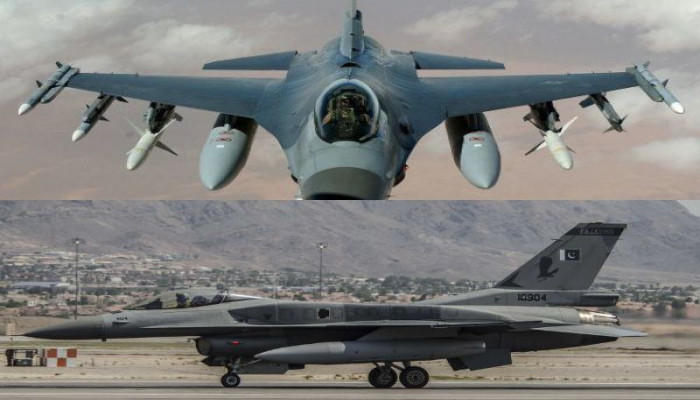US to supply advanced AMRAAM missiles to Pakistan by 2030
- In Reports
- 08:11 PM, Oct 07, 2025
- Myind Staff
Pakistan was included in a new $41.7 million Raytheon contract to produce AMRAAM missiles through 2030, suggesting a possible return of U.S.-Pakistan defence cooperation under the broader Foreign Military Sales program.
As reported by Mohsin Ali on October 6, 2025, the U.S. Department of Defence, now known as the Department of War, recently announced that Tucson, Arizona-based Raytheon was awarded a $41.7 million contract modification to continue production of AIM-120 Advanced Medium Range Air-to-Air Missiles, or AMRAAM, until May 2030. Pakistan was listed among more than 30 allied nations under the Foreign Military Sales framework, pointing to a possible revival of limited defence collaboration between Washington and Islamabad.
The inclusion of Pakistan indicates a potential reactivation of advanced beyond-visual-range capability in the Pakistan Air Force, which previously operated AIM-120C-5 missiles with its F-16C/D Block 52 fleet.
As per reports, Raytheon has received a contract to develop advanced C-8 and D-3 variants of AMRAAM by May 30, 2030. The company release noted that this change is part of a broader Foreign Military Sales program covering over thirty countries, including Pakistan, the United Kingdom, Poland, Germany, Finland, Australia, Romania, Qatar, Oman, South Korea, and Greece.
Other countries included in the agreement are Switzerland, Portugal, Singapore, the Netherlands, the Czech Republic, Japan, Slovakia, Denmark, Canada, Belgium, Bahrain, Saudi Arabia, Italy, Norway, Spain, Kuwait, Sweden, Taiwan, Lithuania, Israel, Bulgaria, Hungary, and Turkey. The new modification ensures ongoing production and delivery of next-generation AMRAAM variants to both U.S. and allied forces.
Reports that Pakistan would receive the AIM-120D-3 variants, which are integrated with the latest electronics, guidance systems, and software upgrades to the standardised configuration. The AIM-120 AMRAAM family remains the principal medium-range radar-guided air-to-air missile for U.S. and allied air forces. Developed as a successor to the AIM-7 Sparrow, AMRAAM introduced an active radar seeker that enables fire-and-forget operation, reducing pilot workload during multi-target engagements.
The missile is powered by a solid-fuel rocket motor capable of speeds up to Mach 4, and its guidance system combines inertial navigation, midcourse data link corrections, and terminal active radar homing. The missile carries a 20-kilogram blast-fragmentation warhead armed with proximity or impact fuzes and is compatible with most modern combat aircraft, including the F-15, F-16, F/A-18, Eurofighter Typhoon, Gripen, and F-35.
AMRAAM has been employed in multiple conflicts since 1991, including the Gulf War, Bosnia, Kosovo, Syria, and the 2019 Jammu and Kashmir airstrikes. The AIM-120D-3, exclusive to U.S. forces, shares the F3R electronics baseline but adds advanced data link and navigation capabilities unique to the D-series. It maintains a two-way data link for midcourse target updates, integration with aircraft sensors and command networks, and GPS-aided inertial navigation for improved trajectory control and accuracy. The D-3’s range typically exceeds 160 kilometres under favorable launch conditions. Its enhanced processor allows ongoing software upgrades, enabling new capabilities without structural modifications.
The D-3 integrates with fifth-generation aircraft like the F-35, supporting cooperative engagement and forming part of networked air defence systems. Pakistan's last confirmed operational use of AMRAAM was during the February 2019 engagement over Jammu and Kashmir. The current development may reflect renewed engagement between U.S. and Pakistani defence authorities, allowing Pakistan to participate in shared AMRAAM production while retaining access to modern missiles for its F-16 fleet under existing agreements.
Given India’s rapid modernisation of fleet with the induction of Rafale jets, Pakistan has been reportedly lobbying for the acquisition of new-generation AMRAAMs to replace its ageing AIM-120C-5 variants, supplied along with the F-16 Block 52 aircraft in 2010. The latest decision is believed to be an outcome of high-level meetings held by Pakistan Air Force Chief Air Marshal Zaheer Ahmed Baber Sidhu with US leaders on their visit to Washington in July 2025. The meetings, which were described as “landmark” discussions by diplomatic insiders, were focused on defence cooperation, counter-terrorism, and regional stability. Pakistan Field Marshal Asim Munir has also held meetings with President Donald Trump and other defence officials.
The announcement, coming shortly after the United States' assistance to Pakistan in repairing F-16 jets damaged during India’s “Operation Sindoor", marks the first concrete sign of renewed strategic engagement between the two sides after years of strained ties. With this, the Pakistan-US military relations are once again entering a phase of pragmatic defence cooperation.







Comments